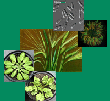| Brauer, M; Zhong, WJ; Jelitto, T; Schobert, C; Sanders, D; Komor, E: Free calcium ion concentration in the sieve-tube sap of ricinus communis l. Seedlings, Planta, 206, 103-107 (1998) | |
| Abstract: Changes in free Ca2+ in sieve-tube sap have been proposed to be important in the regulation of phloem transport, and Ca2+-activated protein kinase activity has been described in phloem exudate (S.A. Avdiushko et al. 1997 J Plant Physiol 150: 552-559). Using atomic absorption spectrometry, we have determined that the total Ca2+ concentration in sieve-tube sap from Ricinus seedlings containing the endosperm is about 100 mu M (range 80-150 mu M). We used three independent methods to determine the free calcium ion concentration in the phloem sap ([Ca2+](p)). The first method was to calculate [Ca2+](p) from the total Ca2+ concentration, in combination with the binding constants and concentrations of the ionic solutes in phloem sap. The resultant estimate of [Ca2+](p) was 63 mu M. The second method used the Ca-specific fluorescent dye 2-[2-(5-carboxy)oxazole]-5-hydroxy-6-aminobenzofuran-N,N,-O-triacetic-acid (FURAPTRA) on exuded sieve-tube sap. Although the sap interfered severely with the fluorescence properties of the dye, Ca2+ titrations enabled a value of [Ca2+](p) = 20 mu M to be deduced. The third method used Ca2+-selective microelectrodes on exuded sap samples, which gave an average value for [Ca2+](p) = 13 mu M. No significant change in this value was observed during the sap exudation period. The Ca2+ buffer capacity was determined and the result of about 0.6 mmol.l(-1).pCa(-1) displayed excellent agreement with the measured values of free and total Ca2+ concentration in sieve-tube sap. Since the measured values for free Ca2+ are 20- to 100-fold higher than those usually reported for the cytosol of a range of plant cells in resting conditions, it is concluded that either regulation of [Ca2+](p) is of limited physiological importance, or that the Ca2+-dependent proteins respond only to relatively high [Ca2+](p). The implications for regulation of cytosolic free Ca2+ in symplastically connected companion cells is discussed. |

